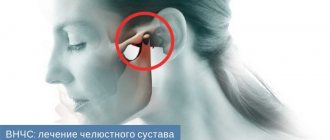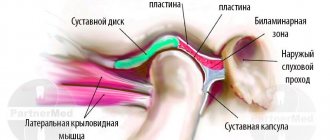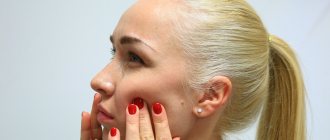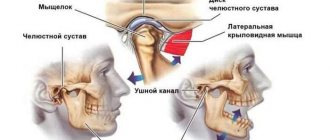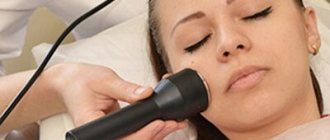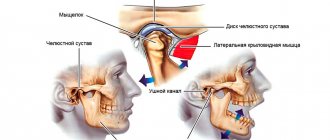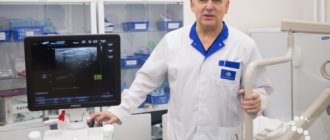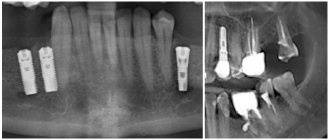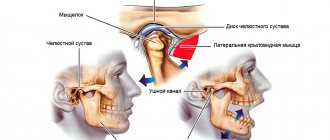If a person feels pain in the jaw, radiating to the ear and temple, we may be talking about arthritis of the mandibular joint. The pathology is not just painful, but also dangerous. If not diagnosed in a timely manner, it can lead to severe complications, including paralysis of the facial nerves. Therefore, the first thing to do when such symptoms appear is to consult a specialist. In 10-18% of cases, diagnosis and treatment of TMJ arthritis is the responsibility of dentists and occurs in people from 25 to 45 years old.
Causes of temporomandibular joint arthritis
Arthritis does not show pronounced symptoms immediately; its development can be asymptomatic for a long time or with minor pain. Out of habit, a person reacts to pain by taking painkillers, which only makes the situation worse. Anesthetics relieve symptoms, but do not remove the cause. The disease “takes over” more and more healthy tissue and, as a result, instead of treatment, the patient receives disability. Let's figure out why TMJ arthritis can develop.
- 1. Mechanical injury. Impact, the habit of clenching teeth tightly, and active chewing of hard food can lead to damage to one or more components of the joint. Articular tissues respond to damage with pain and dilation of blood vessels. Simply put, blood enters from the vessels directly into the tissue, causing swelling, inflammation, and, if treatment is delayed, suppuration.
- 2. Infection. The inflammatory process develops as a result of pathogenic microorganisms entering the joint through the blood or through direct and contact routes. The direct route of infection involves inflammation of the TMJ as a result of an open wound (knife or gunshot wound). If microorganisms have penetrated into the cartilage from infected muscle or bone tissues, then the pathology of transmission is called contact. All diseases of the oral cavity (as well as ear, nose and throat) can lead to arthritis of the temporomandibular joint through the hematogenous route, through the blood.
- 3. Systemic inflammation. Some pathologies of an inflammatory nature (herpes, hepatitis, mycoplasmosis, chlamydia, lupus), if not treated in a timely manner, affect connective tissue throughout the body.
Stages of development of arthrosis of the jaw joint
Regardless of the type/type of disease present, several stages of its development are determined.
Stage I
Diagnosed as joint instability.
Based on the results of the X-ray examination, a moderate and uneven, but clearly noticeable narrowing of the joint space is observed, which is caused by the activation of degenerative-dystrophic changes in cartilage tissue.
Stage II
The clinical aspect assumes full compliance with the general symptomatic picture.
X-ray examination shows that all the changes that occur are characterized by the presence of sclerosis and ossification of the lower jaw.
Stage III
The active progression of pathological processes causes a limitation in the functionality of the jaw.
X-ray examination reveals signs of complete degeneration of cartilage tissue, as well as total sclerosis of the surfaces of articular tissues. In addition, the presence of multiple bone growths, as well as noticeable transformations, is noted.
IV stage
If left untreated, degenerative processes in combination with various types of neoplasms cause fibrous ankylosis of the affected joint.
Symptoms of TMJ arthritis
Depending on the cause of the disease and the nature of the inflammation, arthritis manifests itself with the following symptoms:
- sharp pain when moving the jaw. Increases in opening/closing of the mouth, strongly radiates to the temple, back of the head, tongue;
- when you try to open your mouth wider, the jaw moves to the side;
- inability to close teeth tightly;
- hearing loss, dizziness;
- crunching when moving the jaw.
If at least 2 signs are detected, we recommend that you do not wait for the consequences, but contact the dentist. Correct diagnosis ensures the necessary treatment and recovery in a short time. In the later stages, the dentist will not help. And treatment will cost much more.
If you have a problem similar to that described in this article, be sure to contact our specialists. Don't diagnose yourself!
Why you should call us now:
- We will answer all your questions in 3 minutes
- Free consultation
- The average work experience of doctors is 12 years
- Convenient location of clinics
Single contact phone number: +7
Make an appointment
Comprehensive treatment of TMJ
When the doctor has determined the cause of the joint pathology, or causes, he determines the patient's readiness for a comprehensive treatment plan. In addition to the orthodontist, an osteopath or chiropractor may be involved, or even an orthopedist if more complex correction of the musculoskeletal system is required.
The patient should be aware that it is possible to straighten the jaw using a splint or splint, but this will not solve the problem of malocclusion. Orthodontic treatment will be required to correct the bite. If you have already had orthodontic treatment before, then it is more difficult to decide on repeated treatment.
Therefore, first the problem with the joint is solved using a splint or joint splint, then bite correction is carried out, and, if necessary, prosthetics. In parallel, work is underway with an osteopath to restore the muscular corset of the back and neck.
It happens that a patient refuses treatment with braces after the problem with the joint has been resolved. In this case, we warn him about the need to wear a joint splint constantly in order to avoid the recurrence of old problems with the TMJ. After all, a relapse can happen quite quickly due to stress.
How is arthritis of the lower jaw joint treated?
If pain and stiffness symptoms occur, it is necessary to ensure the TMJ rests. Move your jaw less, take only liquid food, and do not clench your teeth tightly. Visiting the dentist is a must. Only a qualified specialist will be able to tell why the joint is inflamed and prescribe the optimal treatment. Diagnosis consists of blood tests and x-rays. Depending on the situation, we recommend:
- cold compresses;
- drug treatment (broad-spectrum antibiotics, painkillers);
- physiotherapy.
If conservative treatment is ineffective, surgery will be prescribed. Traditional methods of treatment are not only ineffective for arthritis of the temporomandibular joint, they are often dangerous. Decoctions, compresses and ointments according to grandmother's recipes can relieve pain and swelling, but they will not remove the cause of the disease; moreover, some of them can inflame the joint even more. The consequences are impossible to predict, especially with the hematogenous method of infection of the joint. 20% of patients who treated themselves develop joint paralysis.
Symptoms of arthrosis of the jaw joint
Considering the etiology, it is worth noting that the development of the disease is gradual. Symptomatic signs begin to appear slightly, and therefore the patient cannot always independently notice what is happening.
The initial symptoms of arthrosis of the jaw joint are clicking, extraneous crunching, and stiffness. Subsequently, during exertion (chewing food or talking), dull pain begins to appear, which can develop into other pathologies (for example, synovitis).
After the first months of symptoms of arthrosis of the jaw joint, a limitation in the mobility of the lower jaw becomes noticeable. Not only stiffness is observed, but also a displacement of the lower jaw to the affected side with a visually noticeable asymmetry of the face.
It is assumed that symptoms may also include: numbness, tingling of the skin, hearing loss, and even headaches or eye pain.
Bursitis
Vascular angiography is performed to determine the boundaries of the inflammatory process. Contrast arthrography is a diagnostic procedure during which a liquid contrast agent (urotrast, cardiotrast, diodone) is injected into the joint cavity, and then X-rays are taken.
If septic bursitis is suspected, aspiration of synovial fluid is performed for analysis using Gram staining and bacteriological culture.
Which doctors should I contact?
The diagnosis and treatment of bursitis is carried out by a doctor - an orthopedic traumatologist or (for purulent bursitis).
Treatment of bursitis
Therapy for the disease must be comprehensive. It begins with ensuring the rest of the pathological joint, relieving swelling and pain. To do this, it is necessary to reduce or completely eliminate movements in the affected joint and minimize the load. For this purpose, orthoses, bandages and other fixing orthopedic devices are used.
Cold compresses reduce swelling and inflammation. Compression bandaging (squeezing the joint with elastic bands or other devices) reduces pain. Traditionally, drug treatment for bursitis begins with the prescription of non-steroidal anti-inflammatory drugs, which help to quickly relieve inflammation and reduce pain. Chondroprotectors are used to restore joint tissue. Antibiotics are prescribed only for bacterial inflammation of the periarticular bursa.
Modern methods of treating acute bursitis include intra-articular injections with glucocorticosteroids. This allows you to reduce the risk of relapse of the disease and quickly relieve pain, reduce swelling of the synovial membrane of the bursa.
Corticosteroid injections are not recommended for septic bursitis.
In addition, to reduce the severity of pain, swelling and accelerate the regeneration of damaged joint tissues, local remedies are used:
- compresses with dimexide, which have a strong absorbable effect;
- ointments with chondroitin sulfate, glucosamine, and collagen;
- ointments with non-steroidal anti-inflammatory components.
In case of septic bursitis, the inflamed bursa is opened and drained, the pus is pumped out and the joint cavity is washed with antibiotics and antiseptics.
Repeat aspiration may be indicated if swelling, tenderness, and erythema persist. In some cases, the patient may be recommended intravenous antimicrobial therapy. In the subacute period, during the chronic course of the process, physiotherapy sessions are required (ultrasound, microcurrents, electro- and phonophoresis, UHF, dry heat, balneotherapy, paraffin therapy), which can effectively relieve local symptoms of bursitis.
Surgery to excise the bursa is a last resort and is used only in very advanced cases of the disease.
Complications
If inflammation develops near a joint, its mobility may be limited and subsequent muscle atrophy.
In most cases, the duration of the disease is limited to one to two weeks and does not pose a serious danger to human health. However, when an infection occurs, the risk of developing an inflammatory process increases, and serous inflammation quickly turns into purulent inflammation. The spread of the purulent process to surrounding tissues can occur as a phlegmonous inflammation with necrosis of the bursa wall and the formation of subcutaneous and intermuscular phlegmon. In advanced cases, long-term non-healing fistulas form.
The breakthrough of pus into the joint cavity leads to the development of purulent arthritis.
Complications can also develop as a result of untreated bursitis - such complications include scar adhesions, tendon rupture, salt deposition in the cavity of the synovial bursa, arthritis (inflammation of the joint), osteomyelitis (inflammation of the bone), sepsis (blood poisoning), complete immobility of the joint (contracture) .
Prevention of bursitis
Preventive measures are aimed at eliminating the causes and risk factors of bursitis:
- thorough cleansing of wound surfaces, treating the wound with antiseptics for cuts, scratches and abrasions;
- timely treatment of infectious and chronic diseases;
- eliminating the possibility of traumatic joint damage;
- moderate and varied physical activity;
- correct warm-up technique before training;
- fight against excess weight;
- prevention of possible injuries with the help of protective devices for joints - knee pads, bandages and others;
- unloading of joints in the presence of occupational risks (if you have to kneel for a long time, you must not forget about knee pads; when working at a computer, provide comfortable support for the forearm, etc.) and undergoing annual preventive examinations.
Sources:
- Great Medical Encyclopedia (BME), edited by Petrovsky B.V., 3rd edition, volume 3.
- Akhtyamova N.E. Modern approaches to the treatment of bursitis (recommendations for an outpatient surgeon) // RMZh. – 2016. – No. 3. – P. 193–196.
- Bursitis of the elbow joint. Clinical recommendations. All-Russian public organization Association of Traumatologists and Orthopedists of Russia. Moscow. 2016.
IMPORTANT!
The information in this section cannot be used for self-diagnosis and self-treatment. In case of pain or other exacerbation of the disease, diagnostic tests should be prescribed only by the attending physician. To make a diagnosis and properly prescribe treatment, you should contact your doctor.
Treatment tactics
If there is no arthrosis, but there is dysfunction, the tactics are as follows:
- determine the root cause and eliminate it, for example, grind teeth and fillings that impede the functioning of the joint, correct prosthetic errors, and correct the bite;
- reduce the load on the joint - the patient is recommended to switch to soft foods, massage the facial muscles and exercises to relax the jaws;
- if the defects are serious, surgical treatment is performed - bone or muscle plastic surgery of the area of dysfunction.
If the doctor determines degenerative changes in the cartilage tissue, treatment for osteoarthritis will be prescribed. With the help of painkillers, they relieve pain. If necessary, a complex of physical therapy is prescribed, for example, laser or ultrasound. Good results are achieved by intra-articular injections of the Noltrex synovial fluid prosthesis, which restore the functionality of the joint by replenishing the missing lubrication.
Arthrosis of the TMJ is successfully treated with intra-articular injections of Noltrex

